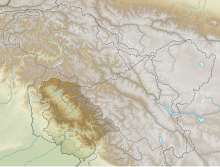| Marusudar | |
|---|---|
 | |
 River map of Jammu and Kashmir | |
| Location | |
| Country | India |
| Flows through | Marwah-Dachhan in Kishtwar district, Jammu and Kashmir |
| Physical characteristics | |
| Source | Nunkun glacier |
| • location | Warwan Valley, Kishtwar, Jammu and Kashmir, India |
| • coordinates | 33°27′25.77″N 75°48′48.99″E / 33.4571583°N 75.8136083°E |
| Mouth | Chenab river |
• location | Bhandarkoot, Kishtwar district, Jammu and Kashmir |
| Length | 133 km (83 mi) approx. |
| Basin features | |
| Dams | Pakal Dul Dam, Bursar Dam |
Marusudar river or Maru Sudar river is the largest river tributary of the Chenab River, beginning at the Nunkun glacier of the Warwan Valley and joining the Chenab at Bhandarkoot in the Kishtwar district. As of 2021, 1000MW Pakal Dul Dam the 800MW Bursar Hydroelectric Project are under construction on this river.
YouTube Encyclopedic
-
1/2Views:522318 690
-
River Tawi all important facts | JKP | JKSSB | BANK | AND ALL OTHER EXAMS
-
India rejects Pakistan’s Objections over Hydro Projects on Chenab #UPSC #IAS
Transcription
Origin
The Marusudar river starts from the Nunkun glacier of the Warwan Valley of the Kishtwar district and joins the Chenab river at Bhandarkoot, Kishtwar. It is 133 kilometres (83 mi) long and the largest river tributary to the Chenab river.[1]
Controversies over Dams
In 2018, Raqib Hameed Naik reported that locals protested against the Bursar Dam project, demanding cancellation of this dam.[2]
While environmentalists have raised concern over the Pakal Dul Dam, claiming that it will have an impact on biodiversity and cause villages to be flooded. According to the Environmental Impact Assessment (EIA), this project will affect 18 hamlets, affecting over 17,000 people, and clearing around 1150 ha of forest area. As per EIA, the dam could obstruct fish migration during the season, impacting endemic fish species and reproductive areas. This involves a site visit and the MoEFF's environmental approval. However, the proposal was approved without a site visit, causing indignation among the locals.[3]
References
- ^ Romshoo, Shakil, Altaf, Sadaff, Amin, Muzamil, Ameen, Ummer (2017). "Sediment Yield Estimation for Developing Soil Conservation Strategies in GIS Environment for the Mountainous Marusudar Catchment, Chenab Basin, J&K, India". Journal of Himalayan Ecology and Sustainable Development. 12: 16–32. ISSN 0973-7502.
- ^ Raqib Hameed Naik (8 May 2018). "Protests Against the Bursar Dam in Jammu and Kashmir Grow Louder". The Wire. Retrieved 10 September 2021.
- ^ "Stop the Dam(ned) Project: Outrage over the Bursar Hydroelectric Project". 21 January 2018. Retrieved 10 September 2021.
